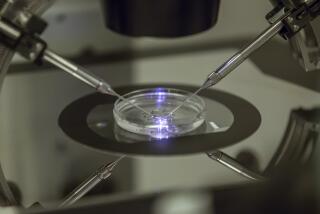Gene Transfer From Woman’s Egg Attempted
- Share via
SAN FRANCISCO — Using a technique similar to the one that Scottish scientists used to clone Dolly the sheep, doctors in New York have for the first time transferred genes from an infertile woman’s egg into another egg, fertilized it with sperm, and placed the resulting embryo in the womb in the hope that it will develop into a baby.
The new approach, which could allow infertile women to have genetically related babies, does not constitute cloning, because any resulting child would have genes from a father as well as a mother. But it is similar enough to cloning to be illegal in California and perhaps in other states where broadly worded anti-cloning legislation has been passed, said Jamie Grifo, the New York University doctor who is leading the experiments.
The technique has not yet succeeded in making a woman pregnant. Grifo said he and his colleagues John Zhang and Hui Liu have tried the method in two infertile women so far. The first one, a 47-year-old, failed to get pregnant. The second woman, 44, underwent the procedure just last week and is not scheduled to get a pregnancy test until next week. The team has permission from the university’s scientific and ethics advisory board to try the technique in five women.
The work breaks new ethical ground by being the first to mix significant amounts of DNA from two women’s eggs into a single egg. That means any resulting child will have two genetic mothers--although one woman contributes vastly more than the other and so will clearly be the dominant biological mother.
Grifo described the novel approach here Thursday to an electrified audience at the annual meeting of the American Society for Reproductive Medicine. Experts said the research offers the latest evidence that in the fast-paced field of reproductive medicine, the line between promising therapeutic techniques and ethically questionable genetic manipulation is getting blurrier every day.
Until now, for example, most researchers have said they are adamantly opposed to making human genetic alterations that would be passed on to future generations. By combining genes from two women, however--albeit to a small extent--the new method does exactly that.
“For the child and family, it raises questions of what bloodline means and what kinship means,” said John Robertson, a professor of law and bioethics at the University of Texas in Austin. “I think in this case that’s OK, but it shows that the germline is not sacrosanct.”
“There are a lot of concerns about this. A lot of issues,” Grifo said. “But it’s not like we did this thoughtlessly.”
The goal, Grifo emphasized, is to provide an alternative for infertile women. Today, the only options for these women are adoption or creation of a baby through in vitro fertilization using an egg donated by another woman.
Many cases of female infertility are caused by an inability to produce eggs. But others, including many among older pre-menopausal women, involve eggs that for one reason or another are defective. The method used by the New York team is based on scientists’ growing recognition that in many of these cases the problem is not with the DNA inside a woman’s eggs but with the fluid, called cytoplasm, that surrounds that DNA. That suggests that their DNA could be used to make a baby if it could be drenched in healthier cytoplasm.
In the new work, the researchers removed the main mass of DNA, called the nucleus, from the infertile women’s eggs and injected it into a healthy donor’s egg whose nucleus had been removed. When the reconstituted egg was mixed with sperm in the laboratory, it began to grow into an embryo that the doctors then placed in the infertile woman’s womb.
By contrast, cloning involves the transfer of nuclear DNA not from an egg but from a body cell, such as a skin cell, into an egg whose own DNA has been removed. Body cells contain a full complement of DNA inherited from two parents (as opposed to the half-dose of DNA present in egg and sperm cells), so no fertilization by sperm is required. A jolt of electricity is enough to get such a reconstituted egg cell to divide as though it were an embryo--genetically identical to the single person who contributed the original skin cell.
Cloning has worked in sheep and mice but has not been attempted in humans.
The ethical catch in Grifo’s work is that there are also some genes, called mitochondrial genes, that reside in the cytoplasm of every egg. Any baby born by his technique will have nuclear genes from the infertile woman and mitochondrial genes from the healthy donor.
Mitochondrial genes are not generally considered to have an obvious impact on how a person looks or behaves. But they do play a major role in various metabolic pathways in the body and, when mutated, are known to cause various inherited diseases. They may play a role in such common ailments as Alzheimer’s disease and Parkinson’s disease.
Some experts at the meeting also questioned the ethics of conducting the experiments in women without first testing its safety in monkeys. “Animal colonies cost a fortune to maintain,” Grifo replied. And because of a ban on federal grant money for embryo research, he said, “we have no research dollars.”
In the current studies, the women undergoing the experimental treatment paid part of the cost of the procedure; the rest was absorbed by the NYU clinic, which offers standard fee-for-service infertility treatments.






